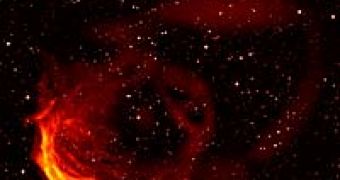Telescope imaging confirms what astronomers have theorized based on computer simulations. Dr Chris Wareing an his colleagues, based at Jodrell Bank Observatory, UK, have found evidence that giant whirlpools form in the wake of stars as they move through clouds in interstellar space.
Initially, Dr Wareing and his colleagues used the COBRA supercomputer to simulate in three-dimensions the movement of a dying star through surrounding interstellar gas.
The dusty building materials of planets come from sun-like stars that expand into bloated red giants at the end of their lives. Their outer layers slowly drift off into space, carrying elements such as carbon that are vital to the origin of life. At a later stage, the stellar ashes become visible as a planetary nebula, a hot blob of gas rich in oxygen, carbon, and nitrogen. Although astronomers knew that these materials were eventually mixed and distributed through space, it wasn't exactly clear how that happened.
Now the group have backed up these predictions with observations of the planetary nebula Sharpless 2-188 taken as part of the IPHAS (Isaac Newton Telescope Photometric H alpha Survey of the Northern Galactic Plane).
The central star of Sharpless 2-188 is 850 light years away and it is travelling at 125 kilometres per second across the sky. Observations show a strong brightening in the direction in which the star is moving and faint material stretching away in the opposite direction. Dr Wareing believes that the bright structures in the arc observed ahead of Sharpless 2-188 are the bowshock instabilities revealed in his simulations, which will form whirlpools as they spiral past the star downstream to the tail.
"These vortices can improve the mixing of the stellar material back into interstellar space, benefiting the next cycle of star formation. The turbulent whirlpools have an inherent spin, or angular momentum, which is an essential ingredient for the formation of the next generation of stars." Said Dr Wareing who developed the computer model during his PhD and is now using it to understand the fate of our Sun.
Images obtained by another group with the 2.5-meter Isaac Newton Telescope on La Palma, Canary Islands, also show vortices in the extremely faint "downstream" part of the nebula, matching the computer simulations.
Scientists are very excited about their finding, as they need this kind of details in order to understand the survival rates of dust particles and complex molecules.
These features should eventually help clarify how stellar material is recycled into new planets and the role of turbulence in creating dense zones of material where complex molecules could persist.

 14 DAY TRIAL //
14 DAY TRIAL //